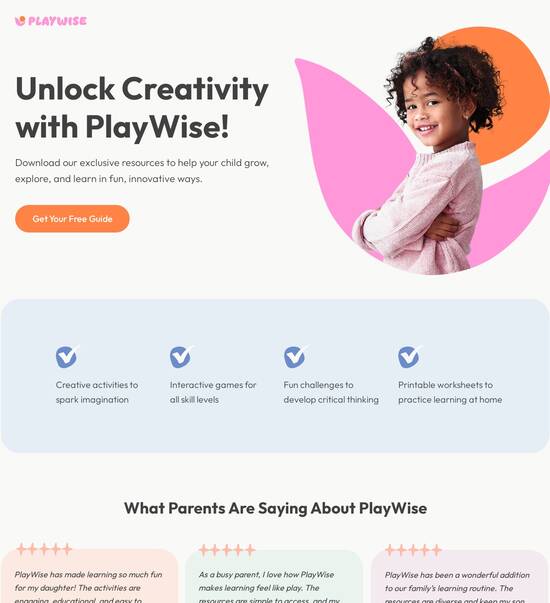
HTML page template for DevOps architects
Use TemplateAbout template
Attract clients and showcase your skills with style using our landing page templates for DevOps architects. Let's convert those visitors into clients!
Recommended templates

Easy to build without coding
With the intuitive drag-and-drop builder, anyone on your team can create high-converting pages without any knowledge of code or design. Make enhancements to your landing page with custom widgets using Javascript, HTML/CSS, or third-party scripts.

Multiple layouts for any industry and goal
Select from 500+ landing page layouts built to boost conversions across industry-specific scenarios. Customize them by adjusting fonts, adding images, and generating on-brand content with the AI assistant. Quickly scale with Instablocks® and Global Blocks that you can save, reuse, and update globally.

Loads fast and looks polished on any device
Every template is responsive, which means they present professionally on any device and load blazingly fast with our Thor Render Engine. You can also power them up with Google AMP technology to deliver an unparalleled mobile experience and drive higher conversions.

Robust analytics & experimentation
Get real-time updates and reporting across all your devices, showing the number of visitors, conversions, cost-per-visitor, and cost-per-lead. Launch AI-powered experiments, run A/B tests, and use heatmaps to analyze user behavior, then optimize your landing page to maximize conversions.







Easy to build without coding
With the intuitive drag-and-drop builder, anyone on your team can create high-converting pages without any knowledge of code or design. Make enhancements to your landing page with custom widgets using Javascript, HTML/CSS, or third-party scripts.
Multiple layouts for any industry and goal
Select from 500+ landing page layouts built to boost conversions across industry-specific scenarios. Customize them by adjusting fonts, adding images, and generating on-brand content with the AI assistant. Quickly scale with Instablocks® and Global Blocks that you can save, reuse, and update globally.
Loads fast and looks polished on any device
Every template is responsive, which means they present professionally on any device and load blazingly fast with our Thor Render Engine.
Robust analytics & experimentation
Get real-time updates and reporting across all your devices, showing the number of visitors, conversions, cost-per-visitor, and cost-per-lead. Launch AI-powered experiments, run A/B tests, and use heatmaps to analyze user behavior, then optimize your landing page to maximize conversions.
All the features you need to build lead-generating landing pages
Explore more featuresLearn how to build top-performing landing pages for any goal
FAQs
Leading the way in building high-performing landing pages





Step-by-step guide to using Instapage for optimizing your landing pages
Leveraging Instapage as your all-in-one landing page and CRO platform can radically enhance your marketing efforts. With more than 100 high-converting templates and pre-built lead generation elements, Instapage ensures that you won’t start from scratch in crafting effective landing pages, vital for accelerating your marketing campaigns.
Understanding the importance of landing pages
Landing pages serve as the first point of contact between your marketing efforts and potential customers. A well-optimized landing page can significantly increase your conversion rates. Instapage provides features that allow you to create robust landing pages without requiring coding knowledge.
- High-converting templates: Choose from over 100 templates designed specifically for conversion, allowing you to quickly launch effective campaigns.
- Built-in lead generation elements: Utilize actionable components like forms and CTAs that engage users immediately.
- Analytics dashboard: Gain insights into visitor behavior, helping refine your strategy and maximize ROI.
Step 1: Building your landing page
Begin by selecting a template that aligns with your campaign goals. This saves time and ensures you have a high-converting framework.
Step 2: Optimize your page for conversions
Once your page is built, it’s crucial to optimize it. Use A/B testing features to experiment with different versions.
- Experiment with headlines: Test variations to see which resonates better with your audience.
- Adjust CTAs: Analyze performance metrics to fine-tune your call-to-action buttons for maximum clicks.
- Utilize heatmaps: Gain insights into where users are clicking most on your page, helping you further optimize layout.
Step 3: Personalize the user experience
Instapage offers powerful personalization tools that allow you to tailor content for specific audience segments. By using dynamic text replacement, you can align your advertisements with relevant landing pages.
- Dynamic text replacement: Automatically change text based on user data for a more personalized experience.
- AdMaps customization: Link specific ads to tailored landing pages that resonate with your target audience.
- Audience tracking: Monitor performance at the audience level to refine targeting and messaging.
In conclusion, using Instapage effectively can transform your marketing campaign's performance by optimizing every aspect of your landing pages.
Ready to turn your landing pages into high-converting machines? Start with Instapage today and see the difference!
HTML page templates for DevOps architects
Understanding the role of HTML page templates in DevOps architecture
HTML page templates play a pivotal role in the world of DevOps architecture. They provide a streamlined structure that helps development teams adhere to design standards while enhancing collaboration. By utilizing standardized templates, teams can quickly develop and deploy applications, ensuring consistent user experiences across different platforms. This is crucial for meeting user expectations in dynamic environments where agility and speed are necessary.
Defining HTML templates within DevOps
HTML templates are pre-designed layouts that provide a reusable framework for developers. They serve multiple purposes within the DevOps architecture, enabling rapid development cycles and improving the efficiency of the overall workflow. These templates are specifically crafted to cater to the distinct requirements of DevOps, where consistency, speed, and collaboration are essential.
In DevOps, having a set of templates fosters a standardized approach, which paves the way for seamless integrations. Templates play a crucial role in ensuring that different teams, whether they are developers or deployment specialists, can work cohesively. This consistency is vital for maintaining code quality and ensuring reliability as projects scale.
Provides a structured approach to front-end development.
Enables rapid prototyping when introducing new features.
Supports version control, ensuring seamless updates.
Features of HTML page templates tailored for DevOps architects
HTML page templates designed for DevOps architects embody several key features that drive efficiency. One notable aspect is their modular design structures, which allow for the reuse of components across various projects. This not only saves time but also encourages teams to maintain uniformity and reduces the chances of errors that can arise from creating new elements.
Another critical feature is the integration of continuous integration and continuous deployment (CI/CD) pipelines. HTML templates can be structured in a way that complements these pipelines, automating elements such as testing and deployment. When templates are aligned with CI/CD processes, teams can ensure that updates are consistently and reliably pushed to production.
Modular design leads to easier maintenance and scalability.
Facilitates automation in testing processes.
Enhances collaboration through a shared understanding of components.
Enhancing collaboration with HTML templates
Templates significantly enhance collaboration among distributed teams. By serving as a common language, they enable teams in various locations to produce consistent results. When everyone is working with the same templates, misunderstandings become less frequent, and project alignment is improved.
Moreover, templates can facilitate collective knowledge sharing. Implementing a comments section for collaborative feedback allows team members to provide insights and suggestions. This kind of dialogue is instrumental in refining processes and improving the overall quality of the final product. By sharing templates and accumulated knowledge, teams can innovate more effectively.
Bridges communication barriers within global teams.
Encourages feedback and input from various perspectives.
Contributes to a unified approach to project development.
Strengthening application through advanced technologies
Incorporating modern frameworks into HTML page templates is essential for DevOps architects. Compatibility with popular front-end technologies like React and Angular allows teams to leverage the full power of JavaScript frameworks while adhering to template structures. The integration of these technologies enhances the dynamism of applications, enabling them to adapt more readily to changing user demands.
Responsive design principles also significantly influence the effectiveness of templates. Ensuring that templates are mobile-first and responsive guarantees that applications are accessible on a variety of devices. This attention to user experience directly impacts performance metrics, leading to better user retention and satisfaction.
Ensures compatibility with modern JavaScript frameworks.
Facilitates a seamless user experience across devices.
Improves interaction rates through optimized performance.
Creating engaging and dynamic content
HTML templates empower teams to manage dynamic content effectively. By establishing content management strategies, teams can update and deploy content without significant downtime. Various tools, such as headless content management systems (CMS), can be integrated with your templates to streamline content updates, ensuring that the website remains current and relevant.
Accessibility features are another crucial aspect of developing HTML page templates. Adhering to inclusive design practices ensures that users with varying abilities can engage with the content seamlessly. Implementing strategies such as keyboard navigation, screen reader compatibility, and contrasting color schemes create a more welcoming environment for all users.
Facilitates real-time updates without compromising performance.
Promotes inclusive experience through accessibility features.
Enhances user engagement by simplifying content management.
Leveraging previews and testing
Real-time previews are invaluable tools during the development process. They provide immediate feedback on changes, helping developers identify and address issues without having to wait for a full build cycle. This capability drastically reduces the time taken to finalize a project. Furthermore, debugging options available within templated setups enhance the clarity of error detection, ensuring that bugs are resolved quickly.
Templates can also aid in rapid prototyping. By allowing developers to create mockups efficiently, they can explore design alternatives without extensive coding requirements. Real-life examples demonstrate that organizations leveraging templated prototypes can gauge user reactions more effectively, guiding design decisions in an informed manner.
Facilitates swift iteration through live previews.
Enhances debugging efforts for smoother development.
Aids in validating concepts through rapid prototyping.
Building a robust knowledge repository
Establishing a centralized template library is essential for effective project management in DevOps. This library serves as a repository for all HTML templates, making it easy for team members to find and utilize existing components. Utilizing tools that support template organization enhances accessibility, allowing team members to retrieve necessary resources quickly. Best practices often recommend tagging and categorizing templates based on their use case to streamline navigation.
A culture of frequent Q&A and community engagement can further bolster this repository. Creating forums where team members can ask questions about template usage fosters an environment of open communication. This practice not only enhances understanding but also encourages knowledge sharing, allowing teams to continuously improve their development processes.
Enhances accessibility through organized template storage.
Encourages collaboration via open forums and Q&A.
Promotes continuous improvement through shared insights.
Analyzing success through data and metrics
Feedback loops are crucial for assessing the effectiveness of HTML templates in the DevOps workflow. Techniques for collecting user feedback can vary from surveys to direct communication channels. This data can provide valuable insights into how well templates are serving their intended purpose. Understanding user experiences can shape the evolution of templates as they adapt to the needs of the development team.
In addition to feedback, tracking access and usage of templates is equally important. Monitoring patterns related to template usage can highlight which components are most valuable and which ones may need improvement. Utilizing analytics tools helps teams gain insights into these metrics, allowing for data-driven decisions that enhance efficacy.
Provides insights into user satisfaction and areas for improvement.
Assists in identifying the most utilized templates.
Facilitates data-driven adjustments to template structures.
Future trends in HTML templates for DevOps
As technology evolves, so too will the methods of template design and development. Emerging technologies are expected to shape the future of HTML templates for DevOps architects. For instance, artificial intelligence and machine learning could play significant roles in automating the creation and modification of templates, allowing for even greater customization that meets specific project needs.
Moreover, serverless architecture could influence how templates are structured, enabling more flexibility in their deployment. DevOps practices will continually evolve, and adapting templates to meet these new methodologies will be critical. Preparing for these changes ensures that teams remain effective and can capitalize on the benefits of next-generation DevOps.
AI may automate template development processes.
Serverless tech could alter template deployment strategies.
Continuous adaptation will be essential for future practices.
Ready to skyrocket conversions?
Supercharge your ad campaigns with high-performing landing pages
Get started














